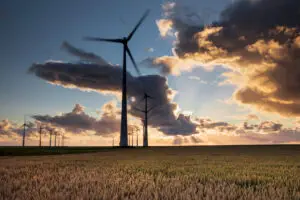 The transition to a world powered by abundant, affordable, fuel-free and emissions-free solar and wind farms is underway. Increasingly, this transition will be driven by economics that favor renewables — and less by government policies and programs. While this trend is our friend, at its current pace, the switch to renewables will not happen fast enough or on a broad enough scale to eliminate our use of fossil fuels. This is necessary to reduce greenhouse gas emissions to stay under internationally agreed-upon limits for global warming. It is unlikely to be a smooth transition, as we are seeing today. There will be bumps and setbacks along the way.
The transition to a world powered by abundant, affordable, fuel-free and emissions-free solar and wind farms is underway. Increasingly, this transition will be driven by economics that favor renewables — and less by government policies and programs. While this trend is our friend, at its current pace, the switch to renewables will not happen fast enough or on a broad enough scale to eliminate our use of fossil fuels. This is necessary to reduce greenhouse gas emissions to stay under internationally agreed-upon limits for global warming. It is unlikely to be a smooth transition, as we are seeing today. There will be bumps and setbacks along the way.
The growth of renewables is accelerating.
We still depend on fossil fuels for over 80% of our energy needs. Today, renewable energy from solar and wind accounts for about 7% of global energy production. In 2023, about 18% of global automobile sales were electric vehicles (EVs). A growing share of electricity is produced using renewables, reaching 21% in the U.S. and 30% globally last year.
These low percentages mask the fact that green energy, especially from solar and wind farms, as well as electric vehicles and battery storage, is starting to exhibit exponential growth. Technology and economies of scale are rapidly improving, leading to further cost reductions and performance improvements.
The cost of electricity from solar has dropped steadily and dramatically mainly due to competition between manufacturers in China where over 90% of the world’s solar cells are made. Additional cost reductions are likely due to increasing economies of scale and technology improvements.
The transition to a world powered by abundant, affordable, fuel-free and emissions-free solar and wind farms is underway. Increasingly, this transition will be driven by economics that favor renewables — and less by government policies and programs. While this trend is our friend, at its current pace, the switch to renewables will not happen fast enough or on a broad enough scale to eliminate our use of fossil fuels. This is necessary to reduce greenhouse gas emissions to stay under internationally agreed-upon limits for global warming. It is unlikely to be a smooth transition, as we are seeing today. There will be bumps and setbacks along the way.
According to the BloombergNEF New Energy Outlook 2024, “The energy transition has accelerated in recent years with the pace of clean technology deployment and capital investment surging to record levels.” The use of electric vehicles (EVs) will grow as the cost of EVs reaches parity with gasoline and diesel-powered vehicles, the range and rapid charging of EVs improves, as well as when charging stations become more common.
A possible risk.
The U.S. is the only large developed country that is self-sufficient in oil and gas, thanks to the fracking revolution and our abundant fossil fuel reserves. Others — such as China, Japan, Europe and rapidly developing India — have more incentive to embrace renewables to reduce their dependence on imported fossil fuels. China and India also have huge air pollution problems that can be reduced by the transition to renewables.
There is a danger that the U.S. will resist the growth of renewables to preserve its fossil fuel industry as long as possible and to protect domestic vehicle manufacturers. If so, the U.S. would fall further behind China in the development and production of solar panels, wind turbines, batteries and electric vehicles.
The grid we need.
The modernization and expansion of the electric grid is an essential first step to electrify the economy by distributing more than twice the amount of today’s electricity output, and to connect the best locations for renewable energy production to the grid. Today, thousands of solar and wind projects are waiting for grid connections. A number of states, such as those in New England, do not have the potential for large wind and solar projects due to climate, land area and other factors. These states will have to import much of their renewable electricity from other windier and sunnier areas, much as many states import most of their fossil fuels today.
What’s needed is a national system that is the equivalent of today’s national pipeline network. For example, the longest natural gas pipeline in the U.S., the 1700-mile-long Transcontinental Pipeline, connects West Texas to New York City.
In addition to the transmission system, the capacity of local electricity distribution systems needs to be increased. We will have to provide for charging electric vehicles, the transition from gas furnaces to heat pumps and other changes that substantially increase the local demand for electricity.
Leave a Reply